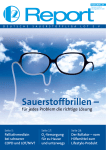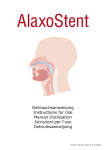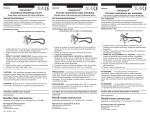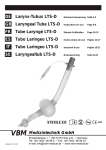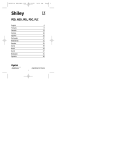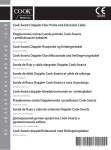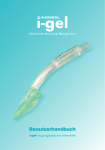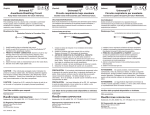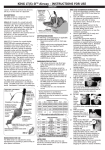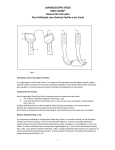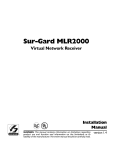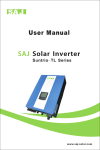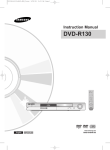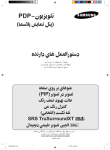Download English Instructions for Use Mode d`emploi en
Transcript
English Instructions for Use
490-•*!"4`.*•0"•••••• !"7!&•fOF
Silicone KING LAD® I Flexible KING LAD I Standard ClearSealTM KING LAD I Flexible ClearSeal KING LAD
INDICATIONS
The Silicone KING LAD (Laryngeal Airway Device) and
Flexible KING LAD and Standard and Flexible ClearSeal
KING LAD airways are single use devices supplied sterile and ready to use. Sterilization is by ethylene oxide.
The Silicone KING LAD and ClearSeal KING LAD are
MRI compatible, whereas the Flexible KING LAD is not.
DESCRIPTION
The KING LAD is a latex free oral airway consisting of
a tube with an elliptical cuff fitted at the distal end,
which inflates in the hypopharynx around the posterior perimeter of the larynx. The KING LAD is
designed to manage the airway during routine and
emergency anesthetic procedures and to establish a
clear airway during resuscitation. The KING LAD is
inserted so that the distal end of the mask abuts
against the base of the hypopharynx, behind the
cricoid cartilage, and the cuff is then inflated to form
an airtight seal around the larynx.
The Flexible KING LAD is used the same as the
Silicone and ClearSeal KING LAD devices; however, it
has a wire-reinforced, flexible airway tube. By removing the breathing circuit connection from the surgical field, the Flexible KING LAD can be used in situations where a Silicone or ClearSeal KING LAD are not
suitable. It can be used for procedures where the
surgeon and anesthesia provider are competing for
access, such as procedures involving the head or
neck. It is also suitable for intra-oral and nasopharyngeal operations as it acts as a barrier against soiling of the glottis or trachea by blood or secretions
from above.
Inflation &
Deflation Valve
Pilot Balloon
15 mm
Connector
Pilot Tube
Airway Tube
RECOMMENDED PATIENT WEIGHT
Inflation
Cuff
1
Neonatal
Up to 5 kg
3 Child
30 - 50 kg
2
Infant
10 - 20 kg
5 Adult
> 70 kg
1.5 Neo/Infant
5 - 10 kg
2.5 Infant/Child 20 - 30 kg
4 Adult
50 - 70 kg
PRECAUTIONS
1. The KING LAD must be used by appropriately
trained medical practitioners.
2. The KING LAD does not prevent regurgitation or
aspiration. Its use in anesthesia should be
restricted to fasting patients. Do not use the
KING LAD without taking appropriate precautions to ensure the stomach is empty.
3. If laryngospasm occurs, treat the cause without
removing the KING LAD. Remove once reflexes
are fully competent.
CONTRAINDICATIONS
Do not use the Silicone KING LAD, ClearSeal KING
LAD, or Flexible KING LAD as a substitute for an
endotracheal tube in the following airway patients
due to the potential risk of regurgitation and aspiration:
•
•
Patients who have not fasted, including patients
whose fasting cannot be confirmed.
Patients who are grossly or morbidly obese, more
than 14 weeks pregnant or those with multiple
injury, acute abdominal or thoracic injury, any
condition associated with delayed gastric emptying, or who have used opiate medication prior to
fasting.
The following contraindications are applicable for
routine use of the KING LAD airways:
•
Because the KING LAD forms a low-pressure seal
around the larynx, it should not be used in
patients with fixed decreased pulmonary compliance, such as patients with pulmonary fibrosis.
•
•
Patients where the peak airway inspiratory pressures are anticipated to exceed 20 cm H2O.
Adult patients who are unable to understand
instructions or cannot adequately answer questions regarding their medical history, as these
patients may be contraindicated for KING LAD
airway use.
In the case of a profoundly unresponsive patient in
need of resuscitation or a difficult airway patient on
an emergency pathway (i.e. “cannot intubate, cannot
ventilate”), the risk of regurgitation and aspiration
must be weighed against the potential benefit of
establishing an airway. The KING LAD airways should
not be used for resuscitation or in emergency situations involving patients who are not profoundly
unconscious and who may resist KING LAD insertion.
PRE-USE CHECK
Choose an appropriately sized KING LAD based on
patient weight, using the sizing information. Prior to
use, remove the valve actuator and test cuff inflation
system by inflating to maximum volume.
INSERTION
1. Prepare the KING LAD for insertion by removing
all the air in the cuff by pushing on the cuff with
middle and index finger while deflating the cuff
with a syringe. This creates a stiff thin leading
edge necessary to insert the KING LAD. Lubricate
the back of the cuff thoroughly just before insertion. Do not lubricate the front as this may result
in aspiration of lubricant.
2. Anesthesia must be deep enough to permit
insertion.
3. Position the head and neck as for normal intubations. Keep the neck flexed and the head extended by pushing on the occiput with one hand
while inserting the cuff into the mouth with the
other hand.
4. When inserting the KING
LAD, hold it like a pen with
the index finger at the
junction of the cuff and
tube. Press the tip up
against the hard palate and
ensure it lies flat and that
the tip is not folded over.
5. Using the index finger,
push the mask backwards
maintaining
pressure
against the palate.
6. As the cuff moves downwards, the index finger
maintains pressure backwards against the posterior
pharyngeal wall to avoid
collision with the epiglottis.
Insert the index finger fully
into the mouth to complete insertion. Keep other
fingers out of the mouth.
As insertion progresses, the flexor surface of the
whole index finger should be along the tube,
keeping it firmly in contact with the palate.
7. When resistance is felt, the mask should be fully
inserted and the finger will have been fully inserted into the mouth. Use the other hand to hold
the tube while withdrawing the finger from the
mouth. Avoid inserting with several movements
or jerking the KING LAD up and down in the
pharynx after resistance is felt.
8. Check that the black line on the tube faces the
upper lip before inflating the cuff. To allow the
KING LAD to position itself correctly, do not hold
the tube during inflation. Prior to connecting the
gas supply, inflate the cuff with sufficient air to
obtain a low-pressure seal, not exceeding 60 cm
H2O. Do not over inflate the cuff.
Inflation Volumes
Size 1
Size 1.5
Size 2
< 4 ml
< 7 ml
< 10 ml
Size 2.5 < 14ml
Size 3 < 20 ml
Size 4 < 30 ml
Size 5 < 40 ml
9. Connect to the gas supply, holding the tube to
prevent displacement and gently inflate the lungs
to confirm correct placement. Insert a bite-block
and secure the KING LAD into place. When correctly placed, the tube should be pressed back
into the palate and posterior pharyngeal wall.
10. Confirm proper position by auscultation, chest
movement and verification of CO2 by capnography.
MAINTAINING THE AIRWAY
• Remember that obstruction can occur if the KING
LAD becomes dislodged or is incorrectly inserted.
The epiglottis may be pushed down with poor
insertion technique. Check by auscultation of the
neck and correct by re-insertion or elevation of
the epiglottis using a laryngoscope.
• Malposition of cuff tip into the glottis may mimic
bronchospasm.
• Avoid moving the KING LAD about in the pharynx
when the patient is at a light plane of anesthesia.
• Keep the bite-block in throughout the procedure.
• Nitrous oxide is known to diffuse into cuffs during anesthesia. Accordingly, cuff pressure should
be monitored and air removed if necessary to
maintain proper inflation.
REMOVAL
1. Once it is in the correct position, the KING LAD
is well tolerated until the return of protective
reflexes.
2. KING LAD removal should always be carried out
in an area where suction equipment and the
ability for rapid intubations are present.
3. Look for the onset of swallowing, which indicates
reflexes are almost restored. It is usually unnecessary to perform suction because the correctly
used KING LAD protects the larynx from oral
secretions. Suction equipment should however
be available at all times.
4. Deflate the cuff completely just prior to removal,
although partial deflation can be used to assist in
the removal of secretions.
5. Following removal, discard the single use KING
LAD.
Tilicone"UVWX"YZ[®""V"""\lexible"UVWX"YZ[""V"""Ttandard"]learTeal^_"UVWX"YZ["V"""\lexible"]learTeal"UVWX"YZ["
!"#+2" fQ *+s&%H(< VH{2" €s¤ ©#5hQ V@Z*5Q ]s/J& ™u›^ •2k2<
\M7BT :{8Z ‡HJ2" 1B0 V®^*•'B2 V&.<%|2" V2*P ]^
3•CD*!"4*!3F
f{''2" f'^ =M7Bh2" _¤#'2" 123 KING LAD )*+, R#š< v%‰'Z \¢
\V7ˆ"#2" V&v".3 U2" :@H2" v<v. •#,. 15P ™7B0 !*[Zg"
)*+, *+7^ %^"#5& V[zJQ ]^ KING LAD V2")3 M5( ‘Y w *'Œ"v ]s/J& \£
\_&%T :{8Z V7,U@2" •"<v¡" R*6v3 V7u*{Q3 _Q €H8B2
-v*@5T" }%ˆ 123 %78( *+u3 ’7P `&%2" _BZ V7B'0 V&"OZ •ˆ%( ]s/J& \¦
™u¡ €H82" !"%,3 ˜.<%|2" fQ ‘#{& — *Q -w v*0< \V&v".3 U2" R*@^¡" v<v.
fQ -%‰J•2" ]'•& ¶7•š :{8Z KING LAD )*+, ?"OW5T" OJ0
\‹ˆ#2" R"#q €H82" •"O@Q %^"#5( ‘Y ]s/J& ‘Y —3 \MH2" •")"%^3
1B0 =w-%«*/Q *+52")3 :7/ˆ :Q*j ²:{8Z !"#+2" fQ VH{2" ¹&%H( M5& \¬
V2")3 1B0 -O0*h'B2 ]ŒX‰2" ‡HJ2*Z Vu*@5T—" V7u*{Q3 fQ M–%2"
\•")"%^g"
-%'2 ™2*'@5T" O@Z ™JQ ÅBW52" M5& =KING LAD )*+, V2")3 •[0 \º
\-OP"<
•" ••••• !"R&•$F"-SE
V7Bš¡" _J42" •*+, ?"X23 1B0 V72<O2"< V7{&%Q¡" ¶Œ"#B2"< f7u"#[2" ÅJ(
VQO['2" •"v*«.g" V0#'‰'2 w *[^< R*'@5TU2 ™5'ŒU'Z •*/'2" ¥5J'B2
\™2 ]Bš¡" _7'‰52" ‘*{Q 123 w —#š< ™@/5( V7u*{Q3 ž*5( ‘Y *'j =R*'@5TU2
V±/@( ¶75& •Bz'2" "k$ ‘›^ =R*'@5T—" !*JŠY VB{8Q V&Y .#+Æ V2*P ]^<
\V&.*h2" f7u"#[2" V^*j •,#'Z y%452" MŠ M7BT :{8Z ¥5J'2"
-&%'2 Å4WQÇ -.*/0 :'•& )*+, ˜Y ?"OW5T" -v*0›Z ?*7[2" V2*P ]^
™,#'2" •Bz'2" ]sB& •2• ‘›^ =•2• O@Z %6È -&%Q 1B0 >SÉÊD9 ËOP"<
=]2*52*Z< \™2 V7Bš¡" _7'‰52" Vz[u 123 w —#š< ¥5J'2" _/552 _J42" V+‰2
V+, .<v •2kZ :'•5( *'u3 SÉÊD )*+, R*'@5T" O7@( V7/q -•8JQ V&Y ‘›^
fQ `[•52"< >™2*'@5T" v*@'2"9 )*+‰2" "k$ .*/56" *+7B0 •‰&< _7J452"
©#5h'2" Ì %4•2" — R*;'2" :7/T 1B0 Ì •2• :'58&< \•2k2 ™57PUš
¥5J'2" V'ŒUQ ‘*'|2 ˜.<%|2" M7[@52" <YÍ< %7+z52"< ~7®J5B2 MŒU'2"
V&Y ‘›^ =V7{&%Q¡" -O•5'2" •*&—#2" ]^< \©%6Y -%Q ?"OW5TU2 :'@5h'2"
©O2 *+(*u*7Z :7‰h( *+7B0 •‰& =SÉÊD )*+, R*'@5T" O7@( V7/q -•8JQ
˜k2"< Code oÎ Federal pe§ÏlationÐ Ñitle ÒÓ •,#'Z V&<v¡"< V&k–¡" -.")<
f7u"#[2" V^*{Z ?"X52—" *+7B0 •‰& *'j =)*+‰2" _7J4( V+‰j *+7B0 ˜%h&
‘<³« M®J( ]52"< •*&—#2" ©#5hQ< ]2".O7H2" ©#5h'2" 1B0 V[/z'2"
´.*6 R*'@5T—" ]^ ©%6¡" f7u"#[2" ˜%h( Oˆ \-X+,¡" _7J4( •*j%«
\V7{&%Q¡" -O•5'2" •*&—#2"
RISK OF REUSE
U.S. and International Laws/Regulations require the original device manufacturer to warrant that the product sold
is fit for use according to the scope of its Instructions for
Use and is capable of being tracked back to its original
assembly. If an issue were to arise during use, this requirement allows for the product to be properly tracked and
acted upon in accordance with all applicable laws.
Any reuse of a device labeled as a Single Patient Use
Device (SPUD) on a subsequent patient(s) invalidates the
manufacturer’s requirement to track the product back to
its original assembly. As such, any facility that reuses a
SPUD assumes the role of a manufacturer and must test
and verify the suitability of this (reused) device. This
includes, but is not limited to, the proper level of cleaning,
disinfection and/or sterilization necessary to warrant the
reused device’s fitness for use. In the USA, any facility that
re-processes a SPUD must register with the Food and
Drug Administration under Code of Federal Regulations
Title 21 as a device manufacturer and abide by all applicable federal and state laws regulating device manufacturers. Outside the USA other laws may apply.
0123
15011 Herriman Blvd. I Noblesville, IN 46060
317-776-6823 I 800-642-KING (5464) I Fax 317-776-6827
[email protected] I www.kingsystems.com
Made in China for King Systems.
KING LAD is a registered trademark and ClearSeal is a trademark of King
Systems.
EU Regulatory
Representative
Medical Product Service GmbH
Borngasse 20
35619 Braunfels, Germany
INFM-70 6/10
•••••• !">5?"•="@AB
‘)< •hP 1B0 •2•< •T*JQ Ÿ*['Z KING LAD )*+, .*756" •‰&
R*'@5T—" :/ˆ \Ÿ*['2" O&O•5Z Vš*W2" •*Q#B@'2" ?"OW5T*Z< =-&%'2"
123 *+WHJZ •2•< .*/56—" VHj ‡Hu ?*®u< ?*'42" ¸%•Q •^ M5&
\©#5hQ 14ˆY
'()*!
-v*Q fQ #BW& =MH2" %/0 EHJ52" !"#$ %&%'52 w ")*+, KING LAD :;'&
y%z2" ]^ V5/;Q :{82" V&<*|7Z VH{Z v<XQ }#/uY fQ ~2•5&< E7{(U2"
]HBW2" €7•'2" R#P ‚]ƒBH„ h2"
… ?† #@„B/† 2" ]^ !"#+2*Z ‡H5J( ]52"< =O7@/2"
RU6 !"#+2" %'Q ]^ M{•5B2 KING LAD M7'4( M( Oˆ< \-%‰J•B2
123 yO+& *'j =%&OW52" %7Š•( ‹•( M5( ]52" VŒ.*z2"< V&v*@2" •*7B'@2"
3•CD*!"••E&F KING LAD )*+, R*6v3 M5& \Ž*@ug" •*7B'0 RU6 !"#+B2 •2*T %'Q %7^#(
fQ :Q*{2*Z !"#+2" ¹&%H( `&%q f0 ™2*6vg KING LAD v"O03 M5& \¢
=]BHh2" ?#@B/2" -O0*[2 w ".<*‰Q •*J[2" fQ O7@/2" y%z2" ‘#{& ’7•Z
?"OW5T*Z VH{2" ¹&%H( _Q 1zT#2"< VZ*/h2*Z *+7B0 €s|2*Z VH{2"
:{8( ’7•Z !"#+2*Z VH{2" ‡Hu •2• O@Z M5&< =][B•2" y<%|s2" ~B6
V/B42"< V@7^%2" -).*/2" V^*•2" :7{8( 123 •2• ˜v³& ’7P =f[•Q
\-%‰J•2" R#P !"#+B2 kHJQ %7– w —)*0
]HBW2" •u*‰2" ‹7&X( M5&< \KING LAD )*+, R*6vg VQ)U2" ]$<
Silicone ‚˜)*+, V[&%q EHJZ Flexible KING LAD ?"OW5T" M5&
•u*‰2" ‹7&X( •J‰( •‰&< \)*+‰2" R*6v3 :/ˆ ?*( :{8Z VH{2" fQ
)X@Q EHJ52" !"#$ %&%'52 ‘%Q }#/u•Z X+‰Q ™uY —3 =ClearSeal KING LAD<
\‹7&X52" -v*Q €H« 123 ˜v³& Oˆ •2• ‘¡ ]Q*Q¡"
=VP"%‰2" _ˆ#Q fQ EHJ52" -%Œ"OZ Vš*W2" VBš#2" V2")3 RU6 fQ< \•BhZ
\)*+‰2" R*6v›Z ¶'h72 ²y*j `'0 1B0 %&OW52" M5& ‘Y •‰& \£
*+7^ f{'& — ]52" •—*•2" ]^ Flexible KING LAD ?"OW5T" f{'& ™u›^
-&%'2" ŸY. _¤#Q €/¤ M5& \¦
]^ ™Q"OW5T" f{'& *'j ClearSeal KING LAD <Y Silicone ?"OW5T"
V&v*@2" •—*•2" ]^ M5& *'j ™5/ˆ.<
‘*{Q œ#BZ ]^ •*Z#@š %&OW52" •7/q< ž"%‰2" *+7^ ™,"#& ]52" •*7B'@2"
]^ V/ˆ%2" !*[Z3 M5& \-X+,¡" R*6vg
•T*JQ ™uY *'j \V/ˆ%2" <Y ŸY%2*Z €/(%( ]52" •"!"%,g" ]^ M5& *'j =VP"%‰2"
€s|2*Z ŸY%2" OQ _Q !*J;u—" _¤<
%/0 ?#@B/2" ]^ ˜%‰( ]52" •*7B'@2"< MH2" %/0 M5( ]52" •*7B'@B2 w *|&Y
V'‰'‰2" fQ ]HBW2" •u*‰2" 1B0
V7Œ"#+2" V/4[2" <Y .*QX'2" #B( _J'& ˜k2" X,*•2" .<v •@B& ’7P =~u¡"
VH{2" R*6v3 _Q -OP"< O& ?"OW5T*Z
\1B0Y fQ Vzˆ*h2" •")"%^g*Z <Y ?O2*Z
\©%6¡" O72*Z MH2" ]^
=KING LAD )*+, R*6v3 OJ0 \¬
OJ0 VZ*/h2" _/š›Z ™Z ¸*hQg" M5&
¹&%H(< ‡HJB2 ?*'š
E/j M5&< \}#/u¡" _Q VH{2" _q*[(
!"#+2"
fQ Oj•52"< •J•2" 1B0 )*+‰2" y%q
™7,#( }#/uY
™7,#( ‘#2*Z
?O0 fQ< ©#5hQ _¤< ]^ ™Œ*[B5T"
\~BWB2 y%z2" !"#52"
~BW2" 123 •*J[2" €s¤ M5& \º
€s|2" !*[Z3 _Q VZ*/h2" ?"OW5T*Z
\•J•2" 1B0 _ˆ"#2"
Ÿ*[Q :š#Q
»^*•& =:HT¡ VH{2" ¼#/$ _Q \½
MQ ¢º EHJ52" !"#$ %&%'52 }#/uY
‡HJB2 VHj
¾*‰(*Z ~BWB2 €s|2" 1B0 VZ*/h2"
™J‰52 •2•< ?#@B/B2 ]HBW2" ."O‰2"
+,-•.* /0"1()•*! 23)*!
VZ*/h2" R*6v3 M5&< \-*+B2" _Q ™Qv*4(
_Q =R*6vg" R*'jg MH2" ]^ :Q*{2*Z
M‰j º° Ì ¦° R*Hq¡" ¦
M‰j º 15P
#;&OP R*Hq¡"
¢
_Q \MH2" ´.*6 f&%6¿" f7@/šg" !*[Z3
-v—#2"
©)"#5& ‘Y ]s/J& =R*6vg" V7B'0 ?O[(
M‰j À° Ì º° ‘#s2*/2" ¬
M‰j ¢° Ì º .*sšÍ-v—#2" #;&OP ¢Ôº
1B0 M{•'2" €s|2" _¤< ]^ ™Œ*[Z3 _Q }#/u¡" _Q :Q*{2*Z VZ*/h2"
fh2"
\•J•2"
M‰j À° fQ :ˆY ‘#s2*/2" º M‰j £° Ì ¢° fh2" .*sš R*Hq¡"
£
_/šg" R*6v3 _Q :Q*{2*Z •*J[2" R*6v3 ]s/J& =VQ<*['Z .#@82" OJ0 \À
M‰j ¦° Ì £° Ífh2" %7sš :Hq £Ôº
_Q }#/u¡*Z ¸*hQ·2 ©%6¡" O72" ?"OW5T" M5&< \MH2" 123 :Q*{2*Z
%'@2" €T#5Q
)*+, ´‚%Z <Y •*j%P -O@Z R*6vg" •J‰( •‰& \MH2" fQ _/šg" ••T
\VQ<*['Z .#@82" O@Z ?#@B/2" :6"v :HTY< 1B0¡ KING LAD
456!)*!"7•8•9•: !
¾*‰(*Z ‘#{& }#/u¡" 1B0 v#,#'2" ]HBW2" €W2" ‘Y fQ `[•52" ]s/J& \Á
\w *'ŒUQ w */&.O( "#[B( !*/qY V^%@'Z KING LAD ?"OW5T" •‰& \¢
KING LAD )*+‰2 ž*'hB2< \VH{2" ‡Hu :/ˆ •2•< *7B@2" ¾*H82"
*'j \€H82" —< >_B/2" •*,.39 œ"%H5T—" <OP fQ KING LAD _J'& — \£
V7B'0 RU6 }#/u¡*Z ¸*hQg" •‰& — =¶7•š :{8Z ™@¤< €/|Z
f0 f7@z[J'2" 1¤%'2" 1B0 %&OW52" ]^ ™Q"OW5T" %45[& ‘Y ]s/J&
fQ V7^*j •hJZ VH{2" ‡Hu M5& =)*s2" .O4Q :7š#( :/ˆ< \‡HJ2"
•*q*75P—" •*W(" ‘<v KING LAD ?"OW5T" •‰& — \>f7'Œ*42"9 ?*@z2"
—< \!*'2" fQ MT ½° ©O@5& — -HWJQ €s|Z RX@2" !"%,g !"#+2"
\?*@z2" fQ -O@'2" #B6 fQ Oj•5B2 V/T*J'2"
\VH{2" ‡Hu ]^ Vs2*/'2" •‰&
V2")3 ‘<v V2*•2" V‰2*@Q M5( =-%‰J•2" ]^ ¥J8( <OP V2*P ]^ \¦
GHI*!"J•D:K V&v".3 U2" :@H2" v<v. .#z( .#^ ™52")3 M5( ‘Y 1B0 =KING LAD
\*+2 OP 14ˆY 123 >Vh{@J'2"9
:Q ¬° fQ :ˆY º Ÿ*['2" :Q ¢¬ fQ :ˆY £Ôº Ÿ*['2" :Q ¬ fQ :ˆY ¢ Ÿ*['2"
:Q £° fQ :ˆY ¦ Ÿ*['2" :Q À fQ :ˆY ¢Ôº Ÿ*['2"
:Q ¦° fQ :ˆY ¬ Ÿ*['2" :Q ¢° fQ :ˆY £ Ÿ*['2"
0123
King Systems
´*5•&< }<*‰52" ?O0 fQ -O&O« V2*•Z }*4Q -&%Q v#,< V2*P ]^
•••••• ! #$!%&
!"#+2" .<%Q ]^ •*Z#@š O,#( ˜k2" -&%'2" V2*P ]^ <Y Ž*@ug" 123
!"#$ %&%'( )*+,” -.*/0 123 LAD .*456" %78&9 Silicone KING LAD :;'(
V2*P ]^ M5& *'j9 µ."#z2" V2*P ]^ ™•5^ M( EHJ5B2 .*hQ %/0 ™&O2 KING LAD Flexible ClearSeal< =Flexible KING LAD< =>“?#@B/2" %/0 EHJ52"
<OP -.#z6 %&O[( •‰7^ =>V&#+52" !"%,3 <Y )*+‰2" R*6v3 f0 X‰@2" M5&< -OP"< -%Q R*'@5TU2 V44WQ -X+,Y Standard ClearSeal KING LAD<
©%‰Q ¶5^ !".< fQ VB'5•'2" -OŒ*H2" _Q *+5u)"#Q< €H82"< œ"%H5T—"
?"OW5T*Z M7[@52" !"%,3 M5&< \R*'@5TU2 -X$*,< V'[@Q V2*P ]^ *$O&.#(
VŒ.*z2" ~ˆ"#'2" ]^ <Y Ž*@u·2 KING LAD ?"OW5T" ]s/J& — \!"#+B2 -X+,Y _Q ClearSeal KING LAD< Silicone KING LAD `^"#5& \f7B;&g" O7hjY
‘#Q<*[& f&k2"< ]0#2" ‘"O[^ fQ -O&O« V2*•Z *+7^ 1¤%'2" }*4& ]52"
\`^"#52" "k$ ?O[& U^ Flexible KING LAD *QY =>mpI9 ]h7q*Js'2" f7u%2"
\KING LAD R*6v3
Kin§ SÕÐteÖÐ
Ó×ØÓÓ ÙerriÖan ÚlÛd\ I NobleÐÛilleÜ IN ÝÞØÞØ
ßÓàÌààÞÌÞáÒß I áØØÌÞÝÒÌKING >×ÝÞÝ9 I Fax ßÓàÌààÞÌÞáÒà
âin§ÐÕÐteÖÐãâin§ÐÕÐteÖÐ\coÖ I äää\âin§ÐÕÐteÖÐ\coÖ
\Kin§ SÕÐteÖÐ Vj%« }*h•2 f742" ]^ _Jš
\Kin§ SÕÐteÖÐ Vj%82 f75B‰hQ f75&.*‰( f75QU0 KING LAD< ClearSeal :;'(
#0%O%g!"&•Ahj*"49•9QI•*!"km!).*!
4.p••*!"4q-s*!
medical ÉrodÏct SerÛice GÖbÙ
Úorn§aÐÐe ÒØ
ß×ÞÓå ÚraÏnÎelÐÜ *7u*'2Y
INFmÌàØ ÓÍÓØ
•••••• ! ;<!)=
Flexible <Y Silicone KING LAD< ClearSeal Kin§ LAD ?"OW5T" •J‰( M5&
V7¤%'2" •—*•2" ]^ V7Œ"#+2" V/4[2" -%zhˆ }#/u¡ :&O/j KING LAD
¨€H82"< œ"%H5T—" fQ :'5•Q %z6 v#,#2 •2•< =!"#+2" ©%‰'2 V72*52"
f0 ™PXPX( _J'2 }#/u¡" ¸*hQ3 _Q =)*s2" .O4'Z :7š#52" M5& \Â
:{8Z )*+‰2" _¤< 1B0 O7j•5B2 `^%Z !"#+2*Z f75Œ%2" !:Q _Q ™@¤#Q
KING ‹7/;(< f7{H2" Ã*/zu— _u*'2" MH2" .*q3 R*6v3 M5&< \¶7•š
— f&k2" 1¤%'2" :'8& *'Z =?*@z2" f0 f7@z[J'2" %7– 1¤%'2"
™zs¤ ]s/J& =¶7•š :{8Z }#/u¡" _¤< OJ0 \™@¤#Q ]^ LAD
\?*@z2" f0 M+0*z[u" fQ Oj•52" f{'&
\]HBW2" ?#@B/2" ."O, ¾*‰(*Z< •J•2" :6"v
f&k2" •*|&%'2" <Y =VJ'h2" fQ V7¤%Q <Y -O&O« V2*•Z f7Z*4'2" 1¤%'2"
=.O42" Vj%P< =EÄHJ2" _ †'h( RU6 fQ M7Bh2" _¤#2" O7j•( M5& \¢° •*Z*š›Z <Y =•*Z*š3 -O@Z f7Z*4'2" 1¤%'2" <Y =w *0#/TY ¢¬ f+B'P 1B0 %Q
‘#Z%{2" X7j%( V/ˆ"%Q RU6 fQ ‘#Z%{2" O7hjY ]u*Š fQ `[•52"<
f&k2" <Y =˜#@'2" œ"%^g" %6•5Z €/(%( V2*P V&•Z <Y =.O42" <Y fz/2" ]^ V,*P
\>]^"%,#JZ*j9
\?*@z2" f0 •*z[u—" :/ˆ ‘#7^¡" fQ w ".OWQ !w "<v ‘#QOW5h&
LHI•*!"M!)N"O•P="1.$"4QB•A•*!
"•3 <Y KING LAD _¤< %7s( "•3 v"Ohu" O•& Oˆ ™uY %jk( ]s/J& ª
123 -*+B2" ¯%@5( ‘Y f{''2" fQ< \¶7•š %7– :{8Z ™2*6v3 M(
f{'&< \R*6v·2 M7BT %7– }#BTY ?"OW5T" OJ0 :HT¡ ¼*s|u—"
_^%Z <Y R*6vg" -v*0›Z _¤#2" ¶7•4(< .O42" _'h( RU6 fQ `[•52"
\-%‰J•2" .*®JQ ?"OW5T*Z -*+B2"
"OP3 123 .*QX'2" ]^ ¶7•š %7– :{8Z VH{2" y%q _¤< ˜v³& Oˆ ª
\V7Œ"#+2" V/4[2" ]^ ¥J85B2 V+Z*8Q V2*P
]^ -&%'2" ‘#{& *QOJ0 ?#@B/2" :6"v KING LAD •&%•( •J‰( •‰& ª
\~7HW2" %&OW52" fQ V2*P
\V7B'@2" ."OQ 1B0 f7{H2" Ã*/zu— _u*'2" MH2" .*q3 1B0 !*[Zg" M5& ª
=%&OW52" V7B'0 RU6 •*H{2" :BW5& )<%5J2" O7hjY )*– ‘Y y<%@'2" fQ ª
ª
ª
Deutsche Gebrauchsanweisung
INDICATIONS
Le Silicone KING LAD (dispositif de voie laryngée), le
Flexible KING LAD et le Standard et Flexible ClearSeal KING
LAD sont des dispositifs à usage unique fournis stériles et
prêts à l'emploi. Stérilisation à l'oxyde d'éthylène. Le Silicone
KING LAD et le ClearSeal KING LAD sont compatibles avec
l'IRM, alors que le Flexible KING LAD ne l'est pas.
INDIKATIONEN
Das Silicone KING LAD (Kehlkopfatemwegsvorrichtung) und das
Flexible KING LAD und das Standard und Flexible ClearSeal KING
LAD sind Vorrichtungen zur einmaligen Verwendung, die steril
und einsatzbereit geliefert werden. Sterilisation mit Ethylenoxid.
Das Silicone KING LAD und das ClearSeal KING LAD sind MRTkompatibel, das Flexible KING LAD hingegen nicht.
Silicone KING LAD® I Flexible KING LAD I Standard ClearSealTM KING LAD I Flexible ClearSeal KING LAD
DESCRIPTION
Le DIL KING est un dispositif d’intubation exempt de latex
constitué d’un tube portant un ballonnet elliptique à son
extrémité distale, qui se gonfle dans l’hypopharynx autour
du périmètre postérieur du larynx. Le DIL KING est conçu
pour prendre en charge les voies aériennes pendant les
procédures anesthésiques de routine et d’urgence et pour
maintenir libres les voies aériennes pendant la réanimation. Le DIL KING est inséré de telle sorte que l’extrémité
distale du masque se juxtapose contre la base de l’hypopharynx, derrière le cartilage cartilage cricoïde et que le
ballonnet soit alors gonflé pour former un joint étanche à
l’air autour du larynx.
Le Flexible KING LAD est utilisé comme les dispositifs
Silicone et ClearSeal KING LAD ; toutefois, il dispose d'une
canule flexible à armature métallique. La suppression de la
connexion avec le circuit respiratoire du champ chirurgical
permet d'utiliser le Flexible KING LAD dans des situations
où le Silicone ou le ClearSeal KING LAD ne sont pas adaptés. Il peut être utilisé pour des interventions au cours
desquelles le chirurgien et l’anesthésiste sont en concurrence pour l’accès, comme les interventions qui touchent
la tête et le cou. ll est également adapté pour les opérations intra-orales et nasopharyngées car il agit comme
une barrière contre la souillure de la glotte ou de la trachée par du sang ou sécrétions provenant du haut.
Vanne de
gonflage &
dégonflage
Connecteur
15 mm
1
Néonatal
1.5 Nouveau-né/
Nourrisson
2
Nourrisson
2.5 Nourrisson/
Enfant
ª
Ballonnet
gonflable
Canule
Jusqu’à 5 kg
5 - 10 kg
10 - 20 kg
20 - 30 kg
3
4
5
Enfant
Adulte
Adulte
30 - 50 kg
50 - 70 kg
> 70 kg
PRÉCAUTIONS
1. Le DIL KING doit être utilisé par des praticiens médicaux convenablement formés.
2. Le DIL KING ne prévient pas les régurgitations ou les
aspirations. Son utilisation en cas d’anesthésie doit se
limiter aux patients à jeun. Ne pas utiliser le DIL KING
sans avoir pris les précautions appropriées pour s’assurer que l’estomac est vide.
3. En cas de laryngospasme, traiter la cause sans retirer
le DIL KING . Le retirer une fois que les réflexes sont
totalement compétents.
CONTRE-INDICATIONS
Ne pas utiliser le Silicone KING LAD, le ClearSeal KING LAD
ni le Flexible KING LAD comme substitut pour un tube
endotrachéal dans les patients intubés suivants,en raison
du risque de régurgitation et d'aspiration :
•
ª
ª
Tube Pilote
Ballonnet
Pilote
POIDS RECOMMANDÉ POUR LE PATIENT
•
!"#$ %&%'( -X+,¡ ˜v*@2" ?"OW5T—" 1B0 V72*52" R*'@5T—" _u"#Q `/zJ(
¨KING LAD EHJ52"
U^ =-%‰J•2" R#P €s|2" -HWJQ w —)*0 : ‚{8& KING LAD ‘¡ w "%®u
-.Oˆ ¯*HWu" fQ V5Z*Š V2*•Z f7Z*4'2" 1¤%'2" _Q ™Q"OW5T" ]s/J&
\˜#Œ. ~7B5Z f7Z*4'2" 1¤%'2" _Q R*•2" #$ *'j =vO'52" 1B0 f75Œ%2"
14ˆ¡" €s|2" •*hQ ©O@5( ‘Y M+&O2 _ˆ#5†& f&k2" 1¤%'2"
\!*'2" fQ MT £° V/hu EHJ5B2
— f&k2" <Y •"v*«.g" }*@75T" 1B0 f&.v*[2" %7– ‘#s2*/2" 1¤%'2"
M+W&.*( R#P M+2 V+,#'2" VB±T¡" 1B0 ²y*« v. M&O[( M+J{'&
)*+, R*'@5T— _u"#Q M+&O2 %^"#5( Oˆ 1¤%'2" !—³$ ‘¡ =]¤%'2"
\KING LAD EHJ52" !"#$ %&%'(
Mode d’emploi en Français
Patients n’étant pas à jeun, parmi lesquels les patients
dont l’état à jeun peut pas être confirmé.
Patients présentant une obésité extrême ou morbide,
patientes enceintes de plus de 14 semaines ou
présentant des lésions multiples, des lésions abdominales ou thoraciques aiguës, tout état pouvant être
associé à une vidange gastrique retardée et patients
ayant utilisé des opiacés avant d’être à jeun.
Les contre-indications suivantes sont applicables pour l’utilisation de routine des DIL KING :
•
Comme le DIL KING forme un joint basse pression
autour du larynx, il ne doit pas être utilisé chez les
patients porteurs d’une compliance pulmonaire réduite
fixe, tels que les patients atteints de fibrose pulmonaire.
•
•
Patients dont les pressions inspiratoires de pointe
vont dépasser 20 cm H2O.
Patients adultes incapables de comprendre les instructions ou qui ne peuvent pas répondre de façon
adéquate aux questions relatives à leurs antécédents
médicaux, car ces patients peuvent présenter une contre-indication à l’emploi du DIL KING.
Dans le cas d’un patient profondément insensible ayant
besoin d’une réanimation ou d’un patient difficile à intuber dans le cadre d’un cheminement d’urgence (par exemple, “impossible d’intuber, impossible de ventiler”), le
risque de régurgitation et d’aspiration doit être pesé par
rapport aux avantages potentiels de la mise en place d’une
canule. Les DIL KING ne doivent pas être utilisés pour la
réanimation ou dans des situations d’urgence concernant
des patients profondément inconscients et qui sont susceptibles de résister à l’insertion du DIL KING.
VÉRIFICATION AVANT UTILISATION
Choisissez un DIL KING de la taille appropriée en fonction
du poids du malade en utilisant les informations de
dimensionnement. Avant utilisation, retirez l’actionneur de
vanne et testez le système de gonflage du ballonnet en le
gonflant au maximum de son volume.
INSERTION
1. Préparez l’insertion du DIL KING en retirant la totalité
de l’air contenu dans le ballonnet en appuyant dessus
avec le majeur et l’index tout en le dégonflant avec
une seringue. Il se crée ainsi une bordure fine et raide
nécessaire à l’insertion du DIL KING. Lubrifiez
soigneusement la partie arrière du ballonnet juste
avant l’insertion. Ne lubrifiez pas la partie avant car
cela pourrait provoquer une aspiration du lubrifiant.
2. L’anesthésie doit être suffisamment profonde pour
permettre l’insertion.
3. Positionnez la tête et le cou comme pour une intubation normale. Gardez le cou fléchi et la tête étendue en
appuyant sur l’occiput d’une main tout en insérant le
ballonnet dans la bouche de l’autre main.
4. Lors de l’insertion du DIL KING, tenez-le comme un
crayon avec l’index à la jonction du ballonnet et du
tube. Appuyez l’extrémité contre la voûte du palais et
assurez-vous qu’il repose à
plat et que son extrémité n'est
pas repliée.
5. À l’aide de l’index, poussez le
masque vers l’arrière en maintenant la pression contre le
palais.
6. Pendant que le ballonnet se
déplace vers le bas, l’index
maintient la pression contre la
paroi pharyngée postérieure
pour éviter une collision avec
l’épiglotte. Insérez complètement l’index dans la bouche
pour terminer l’insertion.
Gardez les autres doigts hors
de la bouche. Tandis que l’insertion progresse, toute la
surface des fléchisseurs de
l’index doit se trouver le long
du tube et le maintenir fermement en contact avec le
palais.
7. Quand une résistance se fait sentir, le masque doit être
complètement inséré et le doigt être totalement
inséré dans la bouche. Utilisez l’autre main pour tenir
le tube tout en retirant le doigt de la bouche. Évitez de
procéder à l’insertion en plusieurs mouvements ou de
secouer le DIL KING de haut en bas dans le pharynx
après que la résistance se soit faite sentir.
8. Vérifiez que la ligne noire sur le tube fait face à la lèvre
supérieure avant de gonfler le ballonnet. Pour permettre au DIL KING de se positionner correctement, ne
tenez pas le tube pendant le gonflage. Avant de
procéder à la connexion avec l’alimentation en gaz,
gonflez le ballonnet avec un volume d’air suffisant
pour obtenir un joint basse pression, sans dépasser
60 cm H2O. Ne pas surgonfler le ballonnet.
Volumes de gonflage
Taille 1
< 4 ml
Taille 2,5
< 14 ml
Taille 2
< 10 ml
Taille 4
< 30 ml
Taille 1,5
< 7 ml
Taille 3
< 20 ml
Taille 5
< 40 ml
9. Connectez à l’alimentation en gaz en tenant le tube
pour empêcher le déplacement et gonflez doucement
les poumons pour confirmer que la mise en place est
correcte. Insérez un cale-dents et fixez le DIL KING en
place. Quand il est correctement placé, le tube doit
appuyer sur le palais et la paroi pharyngée
postérieure.
10. Confirmez le bon positionnement par auscultation,
mouvement du thorax et vérification du CO2 par
capnographie.
ENTRETIEN DE LA CANULE
• Souvenez-vous qu’une obstruction peut survenir si le
DIL KING est délogé ou mal inséré. L’épiglotte peut
être poussée vers le bas par une mauvaise technique
d’insertion. Vérifiez par auscultation du cou et corrigez
par l’intermédiaire d’une réinsertion ou d’une élévation de l’épiglotte à l’aide d’un laryngoscope.
• Un mauvais positionnement du ballonnet dans la
glotte peut mimer un bronchospasme.
• Évitez de déplacer le DIL KING aux environs du pharynx
quand le patient est dans une phase d’anesthésie légère.
• Conservez le cale-dent tout au long de l’intervention.
• Le protoxyde d’azote est connu pour diffuser dans les
ballonnets pendant l’anesthésie. De ce fait, la pression du
ballonnet doit être surveillée et de l’air doit en être retiré
si nécessaire pour maintenir un gonflage approprié.
RETRAIT
1. Une fois qu’il est en position correcte, le DIL KING est
bien toléré jusqu’au retour des réflexes protecteurs.
2. Le retrait du DIL KING doit toujours être réalisé dans
une zone où un appareil d’aspiration et des capacités
permettant de procéder rapidement à une intubation
sont présents.
3. Observez l’apparition de la déglutition qui indique que
les réflexes sont presque restaurés. Il n’est en général
pas nécessaire de procéder à une aspiration car, correctement utilisé, le DIL KING protège le larynx des
sécrétions orales. Un appareil d’aspiration doit cependant être disponible en permanence.
4. Dégonflez complètement le ballonnet juste avant le
retrait, bien qu’un dégonflage partiel puisse être utilisé pour aider à l’élimination des sécrétions.
5. Après le retrait, jetez le DIL KING à usage unique.
RISQUE DE RÉUTILISATION
Selon la législation et la réglementation américaines et
internationales, le fabricant du dispositif a l'obligation de
garantir la conformité du produit vendu par rapport à la
portée de son Mode d'emploi et qu'il est possible de
remonter jusqu'à son assemblage d'origine. Durant son
utilisation, si un problème se produit, cette obligation sert
à garantir que le produit peut être correctement tracé et
traité en toute conformité avec la législation en vigueur.
La réutilisation d'un dispositif étiqueté comme étant un
dispositif à usage unique sur un autre patient annule
l'obligation du fabricant de tracer le produit jusqu'à
l'assemblage d'origine. Dès lors, tout établissement qui
réutilise un dispositif à usage unique assume le rôle de
fabricant et doit tester et contrôler la conformité à l'usage
de ce dispositif (réutilisé). Ceci comprend notamment un
niveau approprié de nettoyage, de désinfection et/ou de
stérilisation nécessaire pour garantir la conformité d'utilisation du dispositif réutilisé. Aux États-Unis, un établissement qui retraite un dispositif à usage unique doit s'enregistrer auprès de la Food and Drug Administration dans
le cadre du Code of Federal Regulations Title 21 comme
fabricant de dispositif et respecter la législation fédérale et
nationale applicable régissant les fabricants de dispositifs.
En dehors des États-Unis, la législation internationale peut
s'appliquer.
0123
King Systems
15011 Herriman Blvd. I Noblesville, IN 46060
317-776-6823 I 800-642-KING (5464) I Fax 317-776-6827
[email protected] I www.kingsystems.com
Fabriqué en Chine pour King Systems.
ClearSeal et KING LAD sont des marques commerciales de King Systems.
Représentant agréé
pour l'UE
Medical Product Service GmbH
Borngasse 20
35619 Braunfels, Allemagne
INFM-70 1/10
Silicone KING LAD® I Flexible KING LAD I Standard ClearSealTM KING LAD I Flexible ClearSeal KING LAD
BESCHREIBUNG
Das KING LAD ist ein latexfreier oraler Atemweg bestehend
aus einer Röhre, die am distalen Ende mit einer ellipsenförmigen Manschette bestückt ist, die sich in der Hypopharynx um
den posterioren Umfang der Larynx aufbläht. Das KING LAD ist
dafür ausgelegt, den Atemweg bei Routine- oder
Notfallanästhesieverfahren zu versorgen und bei der
Wiederbelebung einen freien Atemweg zu etablieren. Das
KING LAD wird so eingeführt, dass das distale Ende der Maske
an die Basis des Hypopharynx, hinter dem Ringknorpel
angrenzt, und die Manschette dann aufgeblährt wird, um ein
luftdichte Abdichtung um die Larynx zu bilden.
Das Flexible KING LAD wird wie die Silicone und ClearSeal
KING LAD-Vorrichtungen verwendet; es weist jedoch eine
drahtverstärkte, flexible Atemwegsröhre auf. Wird der
Anschluss zum Sauerstoffgerät vom chirurgischen Umfeld
genommen, kann das Flexible KING LAD in Situationen verwendet werden, wo ein Silicone oder ClearSeal KING LAD nicht
geeignet sind. Es kann für Verfahren verwendet werden, wo
sowohl der Chirurgie als auch Anästhesieversorger Zugang
benötigen, wie beispielsweise bei Verfahren im Kopf- oder
Nackenbereich. Es ist auch für intraorale und nasopharyngeale
Operationen geeignet, da es als Barriere gegen die
Verschmutzung der Glottis oder Luftröhre mit Blut oder
Sektretionen von oben fungiert.
Inflations- und
Deflationsventil
15 mm
Steckverbinder
Führungsschlauch
Führungsballon
Inflationsmanschette
Atemwegsröhre
EMPFOHLENES PATIENTENGEWICHT
1
Neonatal
Bis zu 5 kg
3
Kind
2
Säugling
10 - 20 kg
5
Erwachsener > 70 kg
1.5 Neo/Säugling 5 - 10 kg
2.5 Säugling/Kind 20 - 30 kg
4
30 - 50 kg
Erwachsener 50 - 70 kg
VORSICHTSMASSNAHMEN
1. Das KING LAD muss von entsprechend geschulten medizinischen Fachkräften verwendet werden.
2. Das KING LAD verhindert Regurgitation oder Aspiration
nicht. Dessen Verwendung in der Anästhesie sollte auf
nüchterne Patienten beschränkt werden. Verwenden Sie
das
KING
LAD
nicht
ohne
entsprechende
Vorsichtsmaßnahmen um sicherzustellen, dass der Magen
leer ist.
3. Tritt ein Laryngospasmus auf, die Ursache dafür behandeln, ohne das KING LAD zu entfernen. Entfernen Sie es,
sobald alle Reflexe vollständig intakt sind.
GEGENANZEIGEN
Verwenden Sie das Silicone KING LAD, das ClearSeal KING
LAD oder das Flexible KING LAD bei den folgenden
Atemwegspatienten nicht als Ersatz für einen
Endotrachealschlauch, da ein mögliches Risiko für
Regurgitation und Aspiration besteht:
•
•
Patienten, die nicht nüchtern sind, wie u.a. Patienten bei
denen der Nüchternstatus nicht bestätigt werden kann.
Patienten, die ausgeprägt oder krankhaft fettsüchtig sind,
mehr als 14 Wochen schwanger, oder Patienten mit
mehrfachen Verletzungen, akuter Bauch- oder
Thoraxverletzung und allen Zuständen in Zusammenhang
mit einer verzögerten Magenentleerung oder die vor dem
Nüchternstatus Opiate als Medikation erhalten haben.
Die
folgenden
Gegenanzeigen
gelten
für
die
Routineverwendung der KING LAD-Atemwegsvorrichtungen:
•
Da das KING LAD eine Niederdruckabdichtung um den
Larynx bildet, sollte es nicht bei Patienten mit fester
reduzierter pulmonaler Compliance, wie beispielsweise
Patienten mit Lungenfibrose, verwendet werden.
•
•
Patienten, bei denen ein maximaler Atemwegsdruck bei
der Inspiration von über 20 cm H2O erwartet wird.
Erwachsene Patienten, die nicht fähig sind Anweisungen
zu verstehen oder Fragen zu ihrer Anamnese nicht
adäquat beantworten können, da diese Patienten
eventuell für die Verwendung des KING LAD-Atemwegs
kontraindiziert sind.
Im Falle eines hochgradig unempfänglichen Patienten, der eine
Wiederbelebung benötigt, oder bei einem schwierigen
Atemwegspatienten auf Notfallbahn (d.h. “kann nicht intubiert,
kann nicht beatmet werden”), muss das Risiko einer
Regurgitation und Aspiration gegen den möglichen Nutzen
der Herstellung eines Atemwegs abgewogen werden. Die
KING LAD-Atemwege sollten nicht zur Wiederbelebung oder
in Notfallsituation bei Patienten verwendet werden, die nicht
hochgradig bewusstlos sind und die gegen die Einführung
eines KING LAD Widerstand leisten könnten.
VOR DER VERWENDUNG ZU PRÜFEN
Wählen Sie ein KING LAD der richtigen Größe, die auf dem
Gewicht des Patienten basiert, anhand der Information zur
Größenbestimmung. Entfernen Sie das Betätigungsventil und
Testmanschetteninflationssystem vor der Verwendung, indem
Sie auf das Maximalvolumen aufblähen.
EINFÜHRUNG
1. Bereiten Sie das KING LAD für die Einführung vor, indem
Sie alle Luft aus der Manschette ablassen. Drücken Sie hierfür mit dem Mittel- und Zeigefinger auf die Manschette,
während Sie mit einer Spritze die Luft aus der Manschette
ablassen. Das schafft eine steife, dünne Anlegekante zum
Einführen des KING LAD. Schmieren Sie die Rückseite der
Manschette unmittelbar vor der Einführung gründlich.
Schmieren Sie die Vorderseite nicht, da dies eine Aspiration
des Schmiermittels zurfolge haben könnte.
2. Die Anästhesie muss tief genug sein, damit die Einführung
möglich ist.
3. Positionieren Sie den Kopf und Nacken wie für normale
Intubationen. Halten Sie den Nacken gebeugt und den
Kopf ausgestreckt, indem Sie mit einer Hand auf das
Hinterhaupt drücken, während Sie die Manschette mit der
anderen Hand in den Mund einführen.
4. Wenn Sie das KING LAD einführen, halten Sie es wie einen
Stift mit dem Zeigefinger an der Verbindung zwischen
Manschette und Schlauch. Drücken Sie die Spitze gegen den
festen Gaumen und stellen Sie sicher, dass sie flach aufliegt und die
Spitze nicht überklappt ist.
5. Drücken Sie die Maske mit dem
Zeigefinger nach hinten und
halten Sie dabei den Druck
gegen den Gaumen aufrecht.
6. Wenn sich die Manschette
abwärts bewegt, hält der
Zeigefinger den Druck nach hinten gegen die posteriore
Rachenwand aufrecht, damit eine
Kollision mit dem Kehldeckel vermieden wird. Führen Sie den
Zeigefinger vollständig in den
Mund ein, um die Einführung
abzuschließen. Bringen Sie keine
anderen Finger in den Mund. Bei
der weiteren Einführung sollte
die Beugerfläche des gesamten
Zeigefingers der Röhre entlang
sein und einen festen Kontakt mit
dem Gaumen aufrecht erhalten.
7. Wird ein Widerstand gefühlt,
sollte die Maske vollständig
eingeführt und der Finger wird vollständig in den Mund
eingeführt worden sein. Halten Sie den Schlauch mit der
anderen Hand, während Sie den Finger aus dem Mund
nehmen. Nicht mit mehreren Bewegungen einführen oder
das KING LAD in der Rachenhöhle nach oben und unten
rucken, wenn Widerstand festgestellt wurde.
8. Stellen Sie sicher, dass die schwarze Linie auf der Röhre zur
Oberlippe zeigt, bevor Sie die Manschette aufblähen.
Damit das KING LAD in die richtige Position gebracht werden kann, die Röhre während der Inflation nicht halten.
Bevor Sie mit der Luftzufuhr verbinden, die Manschette
mit
ausreichend
Luft
aufblähen,
um
eine
Niederdruckabdichtung von maximal 60 cm H2O zu erhalten. Die Manschette nicht zu stark aufblähen.
Inflationsvolumina
Größe 1
< 4 ml
Größe 1,5 < 7 ml
Größe 2
< 10 ml
9.
Größe 2,5 < 14ml
Größe 3 < 20 ml
Größe 4 < 30 ml
Größe 5 < 40 ml
Schließen Sie an die Luftzufuhr an, halten Sie dabei die
Röhre, um eine Verschiebung zu verhindern und blähen
Sie die Lungen vorsichtig auf, um die richtige Platzierung
zu bestätigen. Setzen Sie einen Beissschutz ein und sichern Sie das KING LAD. Wenn sie richtig platziert ist, sollte
die Röhre nach hinten in den Gaumen und die posteriore
Rachenwand gedrückt sein.
10. Bestätigen Sie die richtige Position mit Auskultation,
Brustbewegung und Verfizierung von CO2 anhand von
Kapnographie.
AUFRECHTERHALTUNG DES ATEMWEGS
• Vergessen Sie nicht, dass es zu einer Blockierung kommen
kann, wenn sich das KING LAD verlagert oder falsch eingeführt wird. Der Kehldeckel könnte bei einer schlechten
Einführungsmethode nach unten gedrückt werden. Prüfen
Sie das anhand einer Auskultation des Nackens und korrigieren Sie durch die erneute Einführung oder Erhöhung
des Kehldeckels mithilfe eines Laryngoskops.
• Ein Fehlposition der Manschettenspitze im Kehldeckel
kann wie ein Bronchospasmus wirken.
• Das KING LAD nicht in der Rachenhöhle bewegen, wenn
Sich der Patient unter leichter Anästhesie befindet.
• Behalten Sie den Beissschutz währen des gesamten
Verfahrens bei.
• Lachgas breitet sich bekanntermaßen während der
Anästhesie in Manschetten aus. Demzufolge sollte der
Manschettendruck überwacht und bei Bedarf Luft abgelassen werden, um die richtige Inflation zu erhalten.
ENTFERNUNG
1. Sobald das KING LAD richtig positioniert ist, wird es bis
zur Rückkehr von Schutzreflexen gut toleriert.
2. Die Entfernung des KING LAD sollte immer in einem
Bereich durchgeführt werden, wo eine
Absaugvorrichtung und die Möglichkeit für schnelle
Intubationen gegeben sind.
3. Warten Sie auf das Wiedereinsetzen von Schlucken, was ein
Hinweis darauf ist, dass die Reflexe fast wieder hergestellt
sind. Es ist normalerweise nicht notwendig eine Absaugung
durchzuführen, da das richtig platzierte KING LAD den
Larynx vor oralen Sekretionen schützt. Es sollte jedoch stets
eine Absaugvorrichtung zur Verfügung stehen.
4. Lassen Sie die Luft vor der Abnahme vollständig aus der
Manschette ab, auch wenn eine teilweise Deflation bei der
Entfernung von Sekretionen verwendet werden kann.
5. Entsorgen Sie das KING LAD, nachdem es entfernt ist.
RISIKO BEI WIEDERVERWENDUNG
USA und internationale Gesetze/Regelungen verlangen
vom Hersteller des ursprünglichen Geräts, dass sich das
verkaufte Produkt zur Benutzung im Rahmen seiner
Gebrauchsanleitung geeignet ist und bis zum
ursprünglichen Zusammenbau rückverfolgt werden kann.
Wenn während der Benutzung ein Problem auftritt, muss
das Produkt entsprechend dieser Anforderung ordnungsgemäß rückverfogt werden können, damit die notwendigen Maßnahmen nach allen anwendbaren Gesetzen
getroffen werden können.
Jede Benutzung einer Vorrichtung, die als "Vorrichtung zur
einmaligen Verwendung" (SPUD) deklariert wurde, für
weitere Patienten macht die Anforderung in Bezug auf
Rückverfolgbarkeit des Produkts dem Hersteller
gegenüber unwirksam. Jede Organisation oder
Einrichtung, die eine Vorrichtung zur einmaligen
Verwendung (SPUD) wieder verwendet, übernimmt hierdurch die Rolle des Herstellers und muss die Eignung
dieses wiederverwendeten) Produkts testen und verifizieren Das schließt folgende Punkte mit ein, ist aber nicht
auf sie beschränkt: ausreichender Reinigungsgrad, ausreichende Desinfizierung und/oder Sterilisation, die zum
Garantieren der Eignung der wiederverwendeten
Vorrichtung zur Benutzung notwendig sind. In den USA
muss sich jede Organisation oder Einrichtung, die eine
Vorrichtung zur einmaligen Verwendung (SPUD) wiederbearbeitet, bei der Food and Drug Administration
(Arzneimittelzulassungsbehörde in den USA) nach Code of
Federal Regulations Title 21 (US-Gesetzbuch, Nr. 21) als ein
Gerätehersteller registrieren lasen und sich allen Bundesund Landesgesetzen unterwerfen, die sich auf
Gerätehersteller beziehen. Außerhalb der USA können
andere Gesetze gelten.
0123
King Systems
15011 Herriman Blvd. I Noblesville, IN 46060,
317-776-6823 I 800-642-KING (5464) I Fax 317-776-6827
[email protected] I www.kingsystems.com
Hergestellt in China für King Systems.
ClearSeal und KING LAD sind Warenzeichen von King Systems.
Vertreter der
EU-Aufsichtsbehörde
Medical Product Service GmbH
Borngasse 20
35619 Braunfels, Deutschland
INFM-70 1/10
Italiano Istruzioni per l’uso
Silicone KING LAD® I Flexible KING LAD I Standard ClearSealTM KING LAD I Flexible ClearSeal KING LAD
INDICAZIONI
I dispositivi Silicone KING LAD (dispositivo per il controllo delle
vie aeree), Flexible KING LAD, e Standard e Flexible ClearSeal
KING LAD sono dispositivi monouso, forniti sterili e pronti per
l'uso. Vengono sterilizzati per mezzo di ossido di etilene. I dispositivi Silicone KING LAD e ClearSeal KING LAD sono compatibili con la RM, a differenza del modello Flexible KING LAD.
DESCRIZIONE
La KING LAD è una via aerea orale priva di lattice, e comprende un tubo dotato all’estremità distale di una cuffia
ellittica che si gonfia nell’ipofaringe attorno al perimetro
posteriore della laringe. La KING LAD è stata progettata per
gestire le vie aeree durante le procedure anestetiche di routine e d’emergenza, e per stabilire una via aerea pervia
durante la rianimazione. La KING LAD viene inserita in modo
tale che l’estremità distale della maschera sia adiacente alla
base dell’ipofaringe, dietro alla cartilagine cricoidea; quindi,
la cuffia viene gonfiata a formare una tenuta ermetica
attorno alla laringe.
Le modalità di utilizzo del dispositivo Flexible KING LAD
sono le stesse dei modelli Silicone e ClearSeal KING LAD,
con l'unica differenza che questo dispositivo specifico ha
tubo per le vie aree rinforzato con filo metallico. Se si
rimuove dal campo chirurgico la connessione del circuito
respiratorio, è possibile utilizzare il dispositivo Flexible KING
LAD nei casi in cui i dispositivi Silicone o ClearSeal KING LAD
non sono idonei. Può essere usata nelle procedure in cui il
chirurgo e l’anestesista sono in competizione per l’accesso,
come ad esempio le procedure che coinvolgono la testa o il
collo. È anche idonea per gli interventi intraorali e nasofaringei, dato che agisce come barriera contro l’imbrattamento della glottide o della trachea da parte di sangue o
secrezioni provenienti dall’alto.
Valvola di
gonfiaggio e
sgonfiaggio Palloncino
pilota
Giunto da
15 mm
Tubo
pilota
Cuffia di
gonfiaggio
Tubo per vie aeree
PESO RACCOMANDATO DEL PAZIENTE
1
Neonato
Fino a 5 kg
1.5 Neonato/bambino in 5-10 kg
età prescolare
2
Bambino in età
10-10 kg
prescolare
2.5 Bambino in età
20-30 kg
pre-scolare/Ragazzo
3
Ragazzo
30-50 kg
5
Adulto
> 70 kg
4
Adulto
50-70 kg
PRECAUZIONI
1. La KING LAD deve essere usata unicamente da personale medico adeguatamente addestrato.
2. La KING LAD non previene il rigurgito, né l’aspirazione.
Il suo uso in anestesia deve essere limitato ai pazienti a
digiuno. Non usare la KING LAD senza adottare la precauzioni appropriate per garantire che lo stomaco sia
vuoto.
3. In caso di laringospasmo, trattare la causa senza rimuovere la KING LAD. Rimuovere il dispositivo solo quando
i riflessi sono del tutto soddisfacenti.
CONTROINDICAZIONI
Non utilizzare il dispositivo Silicone KING LAD, ClearSeal
KING LAD o Flexible KING LAD in sostituzione del tubo
endotracheale nelle vie aree dei seguenti pazienti, al causa
del possibile rischio di rigurgito o aspirazione:
•
•
Pazienti non a digiuno, compresi quelli il cui digiuno
non può essere confermato.
Pazienti estremamente o patologicamente obesi, con
gravidanze di oltre 14 settimane, o soggetti con lesioni
multiple, lesioni addominali o toraciche acute, condizioni associate a svuotamento gastrico ritardato,
o pazienti che hanno assunto farmaci oppiacei prima
del digiuno.
L’uso di routine delle vie aeree KING LAD comporta le
seguenti controindicazioni:
•
Dato che la KING LAD forma una tenuta a bassa pressione attorno alla laringe, non deve essere usata nei
•
•
pazienti con compliance polmonare diminuita stabile,
come ad esempio quelli con fibrosi polmonare.
Pazienti di cui si prevedono pressioni inspiratorie di
picco delle vie aeree superiori a 20 cmH2O.
Pazienti adulti che non sono in grado di comprendere le
istruzioni o non possono rispondere adeguatamente
alle domande riguardanti la loro anamnesi medica, dato
che in questi pazienti l’uso della via aerea KING LAD può
essere controindicato.
Se un paziente che reagisce in modo trascurabile richiede la
rianimazione, o se un paziente con vie aeree difficili si trova
in condizioni d’emergenza (cioè del tipo “impossibile
intubare, impossibile ventilare”), occorre soppesare il rischio
di rigurgito e aspirazione contro il possibile vantaggio di
stabilire una via aerea. Le vie aeree KING LAD non devono
essere usate per la rianimazione o nelle situazioni d’emergenza che coinvolgono pazienti in stato di incoscienza non
profonda e che potrebbero resistere all’inserimento della
KING LAD.
VERIFICA PRIMA DELL’USO
Scegliere una KING LAD di misura appropriata in base al
peso del paziente, usando l’apposita tabella. Prima dell’uso,
rimuovere il comando della valvola e testare il sistema di
gonfiaggio della cuffia riempiendola d’aria fino al volume
massimo.
INSERIMENTO
1. Preparare la KING LAD per l’inserimento rimuovendo
tutta l’aria nella cuffia mediante una pressione applicata con il dito medio e l’indice, e sgonfiare allo stesso
tempo la cuffia con una siringa. Ciò crea il bordo d’attacco rigido e sottile necessario per l’inserimento della
KING LAD. Appena prima dell’inserimento, lubrificare
accuratamente la parte posteriore della cuffia. Non
lubrificare la parte anteriore dato che ciò può causare
l’aspirazione del lubrificante.
2. L’anestesia deve essere profonda abbastanza da permettere l’inserimento.
3. Posizionare la testa e il collo come nelle intubazioni normali. Mantenere il collo flesso e la testa estesa, spingendo in avanti l’occipite con una mano, mentre con l’altra
si inserisce la cuffia nella bocca.
4. Durante l’inserimento della
KING LAD, impugnarla come
una penna con il dito indice
alla giunzione tra cuffia e tubo.
Premere la punta in alto contro
il palato duro e garantire che
giaccia di piatto e che la punta
non sia ripiegata.
5. Usando il dito indice, spingere
la maschera all’indietro mantenendo la pressione contro il
palato.
6. Non appena la cuffia inizia a
spostarsi all’indietro, il dito
indice mantiene una pressione
nella stessa direzione contro la
parete faringea posteriore per
evitare la collisione con
l’epiglottide. Per completare
l’inserimento, inserire completamente il dito indice nella
bocca. Mantenere fuori di essa
le altre dita. Durante l’inserimento, tenere la superficie
flessoria dell’intero dito indice lungo il tubo, in modo da
tenerlo strettamente aderente al palato.
7. Quando si percepisce una resistenza, la maschera deve
essere completamente inserita e il dito introdotto
interamente nella bocca. Usare l’altra mano per trattenere il tubo mentre si ritira il dito dalla bocca. Evitare
di inserire il dispositivo muovendolo spesso o strattonando su e giù la KING LAD nella faringe dopo aver percepito una resistenza.
8. Prima di gonfiare la cuffia, verificare che la linea nera sul
tubo corrisponda al labbro superiore. Per consentire alla
KING LAD di posizionarsi correttamente, non tenere il
tubo durante il gonfiaggio. Prima della connessione alla
fonte di erogazione del gas, gonfiare la cuffia con aria
sufficiente a ottenere una tenuta a bassa pressione,
senza superare 60 cmH2O. Non gonfiare eccessivamente la cuffia.
Volumi di gonfiaggio
Misura 1 < 4 ml
Misura 1.5 < 7 ml
Misura 2 < 10 ml
Misura 2.5 < 14 ml
Misura 3 < 20 ml
Misura 4 < 30 ml
Misura 5 < 40 ml
9. Collegarsi alla fonte di erogazione del gas trattenendo il
tubo per impedirne la dislocazione e gonfiare delicatamente i polmoni per confermare il posizionamento corretto. Inserire un blocca-morso e fissare in sede la KING LAD.
Una volta posizionata correttamente, premere il tubo indietro nel palato e nella parete faringea posteriore.
10. Confermare il posizionamento appropriato mediante
l’auscultazione, il movimento del torace e la determinazione della CO2 mediante capnografia.
MANTENIMENTO DELLA VIA AEREA
• Si ricordi che la dislocazione o l’inserimento scorretto
della KING LAD possono causare un’ostruzione. Una tecnica d’inserimento inadeguata può spingere l’epiglottide
verso il basso. Verificare la situazione mediante auscultazione del collo e correggere ripetendo l’inserimento o
innalzando l’epiglottide con un laringoscopio.
• Il posizionamento scorretto della punta della cuffia nella
glottide può mimare il broncospasmo.
• Evitare il movimento della KING LAD in prossimità della
faringe quando il paziente si trova in un piano di anestesia leggero.
• Mantenere in sede il blocca-morso per tutta la procedura.
• È noto che durante l’anestesia il protossido d’azoto si
diffonde nelle cuffie. Di conseguenza, monitorare la
pressione della cuffia e rimuovere eventualmente dell’aria per mantenere il gonfiaggio corretto.
RIMOZIONE
1. Una volta in posizione corretta, la KING LAD è ben
tollerata fino al ritorno dei riflessi di protezione.
2. Rimuovere sempre la KING LAD avendo a disposizione
un aspiratore e dove si abbia la possibilità di eseguire
intubazioni rapide.
3. Controllare l’eventuale comparsa della deglutizione, che
indica il ripristino quasi completo dei riflessi. È solitamente inutile usare un aspiratore perché la KING LAD
usata correttamente protegge la laringe dalle secrezioni
orali. È tuttavia consigliabile tenere sempre a disposizione un aspiratore.
4. Prima della rimozione, sgonfiare correttamente la cuffia,
sebbene sia possibile sgonfiarla parzialmente per facilitare la rimozione delle secrezioni.
5. Dopo la rimozione, gettare la KING LAD monouso.
RISCHI DERIVANTI DAL RIUTILIZZO
Le leggi e i regolamenti degli Stati Uniti e di altri paesi
impongono al produttore originale del dispositivo di
garantire che il prodotto venduto è idoneo all'uso indicato nelle istruzioni per l'uso ed è tracciabile. In caso di
problemi durante l'uso, questo requisito consente di rintracciare il prodotto e di prendere le misure previste da
tutte le leggi applicabili.
Qualsiasi riutilizzo di un dispositivo classificato come utilizzabile per un solo paziente alla volta (SPUD) per altri
pazienti renderà nullo l'obbligo del produttore di fornire
informazioni sulla tracciabilità dell'assemblaggio originale.
Pertanto, qualsiasi struttura che riutilizzi un dispositivo
SPUD si assume gli obblighi del produttore e dovrà effettuare opportuni test e verifiche in merito all'idoneità del suo
riutilizzo. Ciò include, a titolo esemplificativo, il grado di
pulizia, disinfezione e/o sterilizzazione necessari a garantire
l'idoneità del dispositivo per l'eventuale riutilizzo. Negli
Stati Uniti, qualsiasi struttura che rilavori un dispositivo
SPUD ha l'obbligo di registrarsi presso l'FDA (Food and
Drug Administration), ai sensi di quanto previsto dalla Code
of Federal Regulations Title 21, come produttore del dispositivo e osservare tutte le leggi federali e statali applicabili ai produttori di dispositivi. Nei paesi diversi dagli Stati
Uniti è possibile che si applichino altre leggi.
Instrucciones de uso en español
Silicone KING LAD® I Flexible KING LAD I Standard ClearSealTM KING LAD I Flexible ClearSeal KING LAD
INDICACIONES
El Silicone KING LAD (dispositivo para las vías aéreas
laríngeas), el Flexible KING LAD, el Standard y Flexible
ClearSeal KING LAD son dispositivos de un sólo uso para las
vías aéreas que se suministran estériles y listos para ser utilizados. Las esterilización se realizó con óxido de etileno. El
Silicone KING LAD y ClearSeal KING LAD son compatibles
con IRM y el Flexible KING LAD no lo es.
DESCRIPCIÓN
El KING LAD es una vía aérea oral sin látex, consiste en un
tubo con un manguito elíptico integrado en el extremo distal, que se infla en la hipofaringe en torno al perímetro posterior de la laringe. El KING LAD está diseñado para controlar la vía aérea durante los procedimientos anéstesicos de
emergencia y habituales y para establecer una vía aérea
despejada durante la reanimación. El KING LAD se inserta de
forma que el extremo distal de la máscara linde contra la
base de la hipofaringe, detrás del cartílago cricoide, después
se infla el manguito para formar un sello hermético en torno
a la laringe.
El Flexible KING LAD se usa igual que los dispositivos
Silicone y ClearSeal KING LAD, no obstante tiene un tubo de
vía aérea flexible reforzado con alambre. Quitando la conexión del circuito de respiración del campo quirúrgico, el
Flexible KING LAD puede utilizarse en situaciones donde un
Silicone o ClearSeal KING LAD no resultan adecuados. Se
puede usar para procedimientos donde el cirujano y el
anestesiólogo dispongan de poco espacio para el acceso,
como en los procedimientos relacionados con la cabeza o el
cuello. También es adecuado para operaciones intraorales y
nasofaríngeas, puesto que actúa como una barrera y evita
que el glotis o la tráquea se manchen con sangre o secreciones de la parte superior.
Válvula de
inflado y
desinflado
Conector
de 15 mm
0123
15011 Herriman Blvd. I Noblesville, IN 46060
317-776-6823 I 800-642-KING (5464) I Fax 317-776-6827
[email protected] I www.kingsystems.com
Fabbricato in Cina per King Systems.
ClearSeal e KING LAD sono marchi registrati di King Systems.
Rappresentante autorizzato
nella Comunità europea
Medical Product Service GmbH
Borngasse 20
35619 Braunfels, Germania
INFM-70 1/10
Manguito
inflable
Tubo de vía aérea
PESO DEL PACIENTE RECOMENDADO
1
Neonatos
Hasta 5 kg
3
Niños 30 - 50 kg
2
Niños pequeños
10 - 20 kg
5
Adulto > 70 kg
1.5 Recién nacidos/Bebés 5 - 10 kg
2.5 Niños pequeños/Niños 20 - 30 kg
4
Adulto 50 - 70 kg
PRECAUCIONES
1. El KING LAD debe usarlo personal médico formado adecuadamente.
2. El KING LAD no impide la regurgitación o la aspiración.
Su uso en anestesia debe restringirse a pacientes que
hayan practicado ayuno anteriormente. No utilice el
KING LAD sin tomar las precauciones adecuadas para
asegurarse de que el estómago esté vacío.
3. Si se produce un laringoespasmo, trate la causa sin retirar el KING LAD. Retírelo una vez que los reflejos sean
completamente competentes.
CONTRAINDICACIONES
No use el Silicone KING LAD o el Flexible KING LAD como
sustitutos de un tubo endotraqueal en los siguientes
pacientes de vías aéreas, debido al riesgo potencial de
regurgitación y aspiración:
•
King Systems
Tubo piloto
Globo piloto
•
Pacientes que no hayan ayunado previamente, incluidos
los pacientes cuyo ayuno no pueda ser confirmado.
Pacientes que sean muy o mórbidamente obesos, con
más de 14 semanas de embarazo o múltiples lesiones,
que tengan lesión aguda abdominal o torácica, cualquier
patología asociada con el vaciado gástrico retrasado o
que hayan usado medicación opiácea previamente al
ayuno.
Las siguientes contraindicaciones se aplican para el uso
habitual de las vías aéreas KING LAD:
•
Debido a que el KING LAD forma un sello de baja presión alrededor de la laringe, no se debe usar en
pacientes con distensibilidad pulmonar disminuida fija,
como los pacientes con fibrosis pulmonar.
•
•
Los pacientes donde las presiones inspiratorias de las
vías aéreas pico se prevea que van a superar 20 cm H2O.
Pacientes adultos que no puedan comprender las
instrucciones o no puedan responder a las preguntas
relativas a su historial médico de forma adecuada,
porque en estos pacientes el uso de una vía aérea KING
LAD puede estar contraindicado.
En el caso de un paciente profundamente insensible, que
necesite la reanimación o un paciente con vías aéreas díficies
en una ruta de emergencia (p. ej. “ no se puede entubar, no
puede ventilar”), se debe sopesar el riesgo de la regurgitación y la aspiración frente al beneficio potencial de
establecer una vía aérea. Las vías aéreas KING LAD no se
deben usar para la reanimación o en situaciones de emergencia en pacientes que no estén profundamente insconscientes y que puedan ofrecer resistencia a la inserción del
KING LAD.
COMPROBACIÓN PREVIA A LA UTILIZACIÓN
Elija un KING LAD del tamaño apropiado para el peso del
paciente, utilizando la información de tamaños. Antes de
usarlo, retire el accionador de la válvula y compruebe el sistema de inflado del manguito inflándolo hasta el volumen
máximo.
INSERCIÓN
1. Prepare el KING LAD para la inserción extrayendo todo
el aire del manguito, presionando el manguito con el
dedo medio y el índice, mientras que desinfla con una
jeringa. Esto crea un borde prominente delgado y rígido
necesario para insertar el KING LAD. Lubrique la parte de
atrás del manguito completamente justo antes de la
inserción. No lubrique la parte frontal porque eso puede
dar como resultado la aspiración del lubricante.
2. La anestesia debe tener un efecto profundo suficiente
como para permitir la inserción.
3. Coloque la cabeza y el cuello como en las intubaciones
normales. Mantenga el cuello flexionado y la cabeza
extendida sujetando el occipucio con una mano mientras que inserta el manguito en la boca con la otra mano.
4. Sujete el KING LAD como un
bolígrafo con el dedo índice en
la unión del manguito y el tubo
mientras que lo esté insertando. Presione la punta hacia arriba contra el paladar duro y
asegúrese de que se asienta de
forma plana y que la punta no
se pliega sobre sí misma.
5. Utilizando el dedo índice,
empuje la máscara hacia atrás
manteniendo la presión contra
el paladar.
6. El dedo índice mantiene la presión hacia atrás, contra la pared
faríngea posterior para evitar la
colisión con la epiglotis mientras que el manguito se va
moviendo
hacia
abajo.
Introduzca el dedo índice completamente en la boca para
completar
la
inserción.
Mantenga los demás dedos fuera de la boca. La superficie flexora de todo el dedo índice debe colocase a lo
largo del tubo, manteniéndolo firmemente en contacto
con el paladar, mientras que la inserción siga avanzando.
7. Cuando se encuentre resistencia, la máscara debe estar
completamente insertada y todo el dedo introducido en
la boca. Utilice la otra mano para sujetar el tubo mientras que retira el dedo de la boca. Evite insertar con varios movimientos o dar tirones al KING LAD hacia arriba
y abajo en la faringe después de que haya encontrado
resistencia.
8. Compruebe que la línea negra del tubo queda frente al
labio superior antes de inflar el manguito. Para permitir
que el KING LAD se coloque por sí mismo correctamente, no sostenga el tubo durante el inflado. Antes de
conectar el suministro de gas, infle el manguito con suficiente aire para obtener un sellado de presión bajo que
no supere 60 cm H2O. No infle excesivamente el manguito.
Volumen de inflado
Tamaño 1 < 4 ml
Tamaño 1,5 < 7 ml
Tamaño 2 < 10 ml
Tamaño 2,5 < 14ml Tamaño 5 < 40 ml
Tamaño 3 < 20 ml
Tamaño 4 < 30 ml
9.
Conecte el suministro de gas, sujetando el tubo para evitar el desplazamiento e infle suavemente los pulmones
para confirmar la colocación correcta. Introduzca un
bloque de mordida y asegure el KING LAD en su sitio. El
tubo debe apretarse contra el paladar y la pared faríngea
posterior cuando esté correctamente colocado.
10. Confirme la colocación correcta con la auscultación, el
movimiento del pecho y la verificación de CO2 por
capnografía.
MANTENIMIENTO DE LA VÍA AÉREA
• Recuerde que el KING LAD se puede obstruir si se
desplaza o está incorrectamente insertado. La epiglotis
puede ser empujada hacia abajo con una técnica de
inserción pobre. Compruebe mediante auscultación del
cuello y corrija volviendo a insertar o elevando la epiglotis usando un laringoscopio.
• La colocación incorrecta de la punta del manguito en la
glotis puede imitar un broncoespasmo.
• Evite mover el KING LAD en la faringe cuando el
paciente esté en un nivel ligero de anestesia.
• Mantenga el bloque de mordida dentro durante el procedimiento.
• Se sabe que el óxido nitroso se difunde a los manguitos
durante la anestesia. Por consiguiente, la presión del
manguito debe ser supervisada y el aire ha de ser extraído, si es necesario, para mantener un inflado adecuado.
EXTRACCIÓN
1. Una vez que esté en la posición correcta, el KING LAD es
bien tolerado hasta el retorno de los reflejos protectores.
2. La extracción del KING LAD debe llevarse a cabo siempre en una zona donde esté presente un equipo de
succión y se puedan realizar intubaciones rápidas.
3. Espere que el paciente empiece a tragar, lo que indicará
que los reflejos estarán casi restaurados. Generalmente
no es necesario realizar la succión porque el KING LAD
usado correctamente protege la laringe de las secreciones orales. No obstante, el equipo de succión debe
estar disponible en todo momento.
4. Desinfle el manguito completamente justo antes de la
extracción, aunque también se puede desinflar parcialmente para ayudar con la extracción de las secreciones.
5. Después de la extracción, deseche el KING LAD de un
sólo uso.
RIESGO DE REUTILIZACIÓN
Las leyes/normativas de EE.UU e internacionales requieren
que el fabricante del dispositivo original garantice que el
producto vendido es adecuado para su uso de acuerdo al
alcance de sus instrucciones de uso y pueda ser seguido
hasta su ensamblaje original. Si se produjera un problema
durante el uso, este requisito permite que el producto sea
debidamente seguido y se pueda actuar respecto a él de
acuerdo a todas las leyes aplicables.
Cualquier reutilización de un dispositivo etiquetado como
dispositivo para un solo paciente (SPUD, por sus siglas en
inglés) en pacientes sucesivos invalidará los requisitos del
fabricante para seguir el producto hasta su ensamblaje
original. Por ello, cualquier instalación que vuelva a utilizar
un SPUD asume el papel de un fabricante y debe comprobar y verificar la idoneidad de este dispositivo (reutilizado).
Esto incluye, pero no está limitado al nivel adecuado de
limpieza, desinfección o esterlización necesario para garantizar la idoneidad para su uso del dispositivo reutilizado. En
Estados Unidos, toda instalación que vuelva a procesar un
SPUD debe registrarse en la Administración de Alimentos y
Medicamentos de acuerdo al Code of Federal Regulations
Title 21, como un fabricante de dispositivos y acatar todas
las leyes federales y estatales aplicables que se apliquen a
los fabricantes de dispositivos. Fuera de los Estados Unidos
pueden aplicarse otras leyes.
0123
Svenska Bruksanvisning
Silicone KING LAD® I Flexible KING LAD I Standard ClearSealTM KING LAD I Flexible ClearSeal KING LAD
ANVISNINGAR
Silicone KING LAD (laryngeal luftvägsenhet) och
Flexibel KING LAD och standard samt flexibel
ClearSeal KING LAD-luftvägar är enheter för
engångsbruk levererade sterila och klara att
användas. Steriliseringsmetoden är med etylenoxid.
Silicone KING LAD och ClearSeal KING LAD är MRIkompatibla medan Flexible KING LAD inte är det.
BESKRIVNING
KING LAD är en latexfri oral luftväg bestående av en
tub med en elliptisk kuff fäst i den distala änden,
vilken blåses upp i hypofarynx runt larynx bakre
perimeter. KING LAD är utformad att tillhandahålla en
luftväg under anestetiska procedurer av rutin- och
nödkaraktär och att upprätthålla öppna luftvägar
under återupplivning. KING LAD förs in så att den distala änden av masken ligger an mot basen i hypofarynx, bakom cricoidbrosket. Kuffen blåses sedan upp
så att den bildar en lufttät förslutning runt la-rynx.
Flexible KING LAD används på samma sätt som
Silicone- och ClearSeal KING LAD-enheter, men har
en trådförstärkt flexibel tub. Genom att ta bort andningskretsanslutningen från operations- området
kan Flexible KING LAD användas i situationer där
Silicone eller ClearSeal KING LAD inte är lämpliga.
Den kan också användas för procedurer där kirurgen
och narkosgivaren båda behöver åtkomst, såsom vid
ingrepp som involverar huvudet eller halsen. Den
lämpar sig också för operationer i mun och
näsa/svalg, då den fungerar som barriär mot
nedsmutsning av glottis och trakea av blod och
sekret från högre liggande delar.
Ventil för
uppblåsning
och tömning
15 mmkontakt
Fabricado en China para King Systems.
ClearSeal y KING LAD son marcas comerciales de King Systems.
Representante para asuntos
reglamentarios en la UE
Medical Product Service GmbH
Borngasse 20
35619 Braunfels, Alemania
INFM-70 1/10
Luftvägstub
REKOMMENDERAD PATIENTVIKT
Uppblåsningskuff
1
Neonatal
Upp till 5 kg
3
Barn
30 - 50 kg
2
Spädbarn
10 - 20 kg
5
Vuxen
> 70 kg
1.5 Neo/spädbarn 5 - 10 kg
2.5 Spädbarn/barn 20 - 30 kg
4
Vuxen
50 - 70 kg
FÖRSIKTIGHETSÅTGÄRDER
1. KING LAD får enbart användas av läkare med
tillämplig utbildning.
2. KING LAD hindrar inte regurgitation eller aspiration. Under anestesi får den enbart användas på
fastande patienter. Använd inte KING LAD utan
att vidta lämpliga åtgärder för att säkerställa att
magsäcken är tom.
3. Om larynxspasm uppträder, behandla orsaken
utan att avlägsna KING LAD. Avlägsna enheten
först då reflexerna är helt återställda.
KONTRAINDIKATIONER
Använd inte KING LAD, ClearSeal KING LAD eller
Flexible KING LAD som ett substitut för en endotrakeal tub i följande luftvägsspatienter på grund av
den potentiella risken för regurgitation och aspiration:
•
•
King Systems
15011 Herriman Blvd. I Noblesville, IN 46060
317-776-6823 I 800-642-KING (5464) I Fax 317-776-6827
[email protected] I www.kingsystems.com
Pilottub
Pilotballong
Patienter som inte är fastande, inklusive patienter
vars fasta inte kan bekräftas.
Patienter som lider av kraftig eller morbid fetma,
patienter som är gravida i 15:e veckan eller
senare, patienter med multipla skador, akut bukeller toraxskada, något tillstånd förknippat med
försenad magsäckstömning eller patienter som
har medicinerats med opiater före fastan.
Följande kontraindikationer är tillämpbara för rutinmässig användning av KING LAD luftvägar:
•
•
Då KING LAD bildar en försegling med lågt tryck
runt larynx ska den inte användas hos patienter
med konstant minskad lungtänjbarhet, t.ex.
patienter med lungfibros.
Patienter där det maximala inspiratoriska trycket i
•
luftvägarna förutsägs överstiga 20 cm H2O.
Vuxna patienter som är oförmögna att förstå
anvisningar eller inte korrekt kan svara på frågor
om sin anamnes, då dessa patienter kan vara
kontraindicerade för användning av KING LADluftvägen.
För ytterst icke-responsiva patienter i behov av
återupplivning eller svårbehandlade luftvägspatienter i en nödsituation (dvs. “kan ej intubera, kan ej
ventilera”), måste risken för regurgitation och aspiration vägas mot möjlig fördel av att etablera en fri
luftväg. KING LAD luftvägar ska inte användas för
återupplivning eller i nödsituationer som involverar
patienter som inte är djupt medvetslösa och som kan
stå emot införande av KING LAD.
KONTROLL FÖRE ANVÄNDNING
Välj en KING LAD av lämplig storlek, baserat på
patientens vikt med hjälp av storleksinformationen.
Före användning ska ventilaktiveraren avlägsnas och
kuffuppblåsningssystemet testas genom att blåsa
upp det till maxvolym.
9. Håll i tuben medan du ansluter gaskällan för att
förhindra att tuben rubbas. Blås försiktigt upp
lungorna för att bekräfta att tuben är korrekt
placerad. För in ett bitblock och säkra KING LAD
på plats. När tuben är korrekt placerad ska den
pressas tillbaka mot gommen och den bakre
svalgväggen.
10. Bekräfta korrekt position genom auskultation,
bröstkorgsrörelse och verifiering av CO2 genom
kapnografi.
UPPRÄTTHÅLLA LUFTVÄGEN
• Kom ihåg att obstruktion kan uppstå om KING
LAD lossnar eller sätts in felaktigt. Epiglottis kan
tryckas ned om felaktig införselteknik används.
Kontrollera placeringen genom auskultation av
halsen och korrigera genom föra in tuben igen
eller genom att lyfta epiglottis med hjälp av ett
laryngoskop.
• Felplacering av kuffens spets i glottis kan
simulera bronkspasm.
• Undvik att flytta runt KING LAD i svalget när
patienten befinner sig i ett ytligt anestesistadium.
• Behåll bitblocket genom hela ingreppet.
• Det är känt att kväveoxid diffunderar in i kuffar
under anestesi. Följaktligen ska kufftrycket övervakas och luft avlägsnas om nödvändigt för att
upprätthålla korrekt uppblåsningstryck.
INLÄGGNING
1. Förbered KING LAD för inläggning genom att
avlägsna all luft i kuffen genom att trycka på kuffen med pek- och långfinger, medan kuffen töms
med en spruta. Detta skapar en styv, tunn
framkant som behövs för att föra in KING LAD. BORTTAGANDE
Smörj den bakre änden av kuffen noggrant strax 1. När KING LAD väl är korrekt placerad tolereras
den väl, till dess att skyddsreflexerna återvänder.
före införande. Smörj inte den främre änden, då
2. KING LAD ska alltid avlägsnas på en plats där
detta kan leda till att smörjmedel aspireras.
det finns sugutrustning och möjlighet till snabb
2. Anestesin måste vara tillräckligt djup för att
intubering.
medge införande.
3. Placera huvud och hals som för normala intu- 3. Var uppmärksam på när patienten börjar svälja,
vilket indikerar att reflexerna nästan är återställberingar. Håll halsen böjd och huvudet utsträckt
da. Vanligen är det inte nödvändigt att utföra
genom att trycka på bakhuvudet med en hand
sugning, eftersom KING LAD när den används
medan kuffen förs in i munnen med den andra
korrekt skyddar larynx från munsekret.
handen.
Sugutrustning ska dock alltid finnas tillgänglig.
4. När KING LAD förs in ska
4. Töm kuffen fullständigt precis innan den tas ut.
den hållas som en penna
Ofullständig tömning kan dock användas för att
med pekfingret vid anslutavlägsna sekret.
ningen mellan kuff och tub.
5. Efter borttagande ska KING LAD för engångsbruk
Tryck upp spetsen mot
kasseras.
hårda gommen och säkerställ att den ligger platt och
att spetsen inte är vikt.
RISK MED ÅTERANVÄNDNING
Lagar/föreskrifter i USA och internationella lagar/föreskrifter
5. Tryck masken bakåt med
erfordrar att originalenhetens tillverkare garanterar att den
hjälp av pekfingret och
sålda produkten är passande för användning i enlighet med
upprätthåll trycket mot
bruksanvisningen och kapabel att spåras tillbaka till originalhårda gommen.
monteringen. Om det uppstår problem under användning
6. Medan kuffen flyttas nedåt
möjliggör det att produkten spåras riktigt och åtgärdas i
ska pekfingret upprätthålla
enlighet med all tillämplig lagstiftning.
trycket bakåt, mot svalgets
bakre vägg, för att undvika
All återanvändning av en enhet etiketterad för engångsbruk
att stöta emot epiglottis.
(SPUD) på en följande patient ogiltigförklarar tillverkarens
För in pekfingret helt i
skyldighet att spåra produkten tillbaka till originalmonterinmunnen för att slutföra
gen. I enlighet med detta skall varje facilitet som återanväninförandet. Övriga fingrar
der en SPUD ta på sig ansvaret som tillverkare och måste
ska hållas utanför munnen.
testa och verifiera lämpligheten av denna (återanvända)
Allteftersom
införandet
fortsätter ska hela pekfingrets insida hållas längs enhet. Det inkluderar, men är inte begränsat till, korrekt
med tuben, vilken ska hållas i stadig kontakt med rengöringsnivå, desinficering och/eller sterilisering nödvändig för att garantera enhetens lämplighet för användgommen.
7. När du känner motstånd ska masken föras in helt ning. I USA måste varje facilitet som omarbetar en SPUD
Food and Drug
och fingret kommer att vara helt infört i munnen. registrera den i enlighet med
Använd den andra handen för att hålla i tuben Administration under Code of Federal Regulations Title 21
medan du drar ut fingret ur munnen. Undvik att som en enhetstillverkare och följa alla applicerbara federala
föra in tuben med flera rörelser eller att rycka och statliga lagar som reglerar enhetstillverkare. Utanför
KING LAD upp och ned i svalget efter att ha känt USA kan annan lagstiftning vara gällande.
motstånd.
8. Innan kuffen blåses upp ska du kontrollera att
den svarta linjen på tuben ligger i linje med överläppen. För att medge korrekt placering av KING
LAD ska du inte hålla i tuben medan kuffen blås0123
es upp. Innan gaskällan ansluts ska kuffen blåsas
King Systems
upp med tillräckligt mycket luft för att åstadkom15011 Herriman Blvd. I Noblesville, IN 46060
ma en förslutning med lågt tryck. Trycket ska inte
317-776-6823 I +1-800-642-KING (5464) I Fax +1-317-776-6827
överskrida 60 cm H2O. Blås inte upp kuffen för
[email protected] I www.kingsystems.com
mycket.
Uppblåsningsvolymer
Storlek 1 < 4 ml
Storlek 1,5 < 7 ml
Storlek 2 < 10 ml
Storlek 2,5 < 14 ml
Storlek 3
< 20 ml
Storlek 4
< 30 ml
Tillverkad i Kina för King Systems.
ClearSeal och KING LAD är varumärken som tillhör King Systems.
Storlek 5 < 40 ml
Representant
för EU Regulatory Affairs
Medical Product Service GmbH
Borngasse 20
35619 Braunfels, Tyskland
INFM-70 1/10


